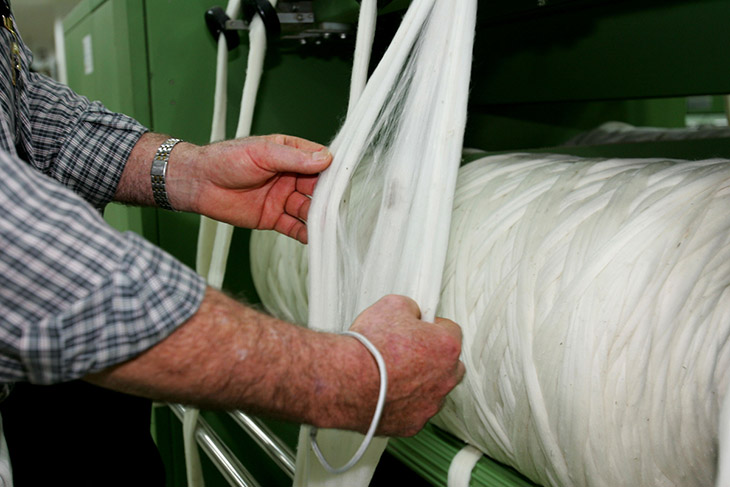Exploring new markets for wool processing, including Australia

Work has commenced on a Government-funded project to assess opportunities for processing more wool in Australia as well as new overseas markets. The aim is to reduce the industry’s reliance on the current limited number of processing markets for Australian wool.
Work has commenced on a Government-funded project to assess opportunities for processing more wool in Australia as well as new overseas markets. The aim is to reduce the industry’s reliance on the current limited number of processing markets for Australian wool.
AWI is working with WoolProducers Australia which was awarded a $662,000 grant as part of the Australian Government’s Agricultural Trade and Market Access Cooperation program, to explore new markets and processing options for Australian wool.
The purpose of this project is to identify opportunities to mitigate and reduce the current risks faced by the Australian wool industry through its reliance on a limited number of export markets.
When announcing the grant in November last year, the then Minister for Agriculture David Littleproud said the funding aims help identify new opportunities for the Australian wool industry.
“Currently, the bulk of Australia’s wool clip is exported to and processed in a small number of markets,” Minister Littleproud said.
“If there’s one thing the global pandemic has taught us, it’s that market diversification is important for healthy industries. By looking for alternative markets for our wool, we can make sure we aren’t falling into the trap of putting all our eggs in the one basket.
“This grant will examine the feasibility of bringing back early-stage processing of greasy wool in Australia. It will also examine the feasibility of early-stage processing in offshore locations, providing our wool producers with new markets.
“It could also mean investment into manufacturing, greater job opportunities in our regions, and a chance to value-add to our wool before export.”
Industry collaboration
The work of the WoolProducers-led project is being guided by a steering committee comprising Australian Wool Innovation (AWI), National Council of Wool Selling Brokers of Australia, Australian Council of Wool Exporters & Processors Inc, Australian Wool Testing Authority (AWTA), Australian Wool Exchange (AWEX) and Austrade.
WoolProducers CEO, Jo Hall, announced in April that Deloitte Access Economics has been engaged to assist with the wide-ranging feasibility study.
“Key considerations that will guide the work of the feasibility study include changing trade patterns, the risk of emergency animal diseases, Australia’s desire to increase its domestic manufacturing capacity, and supply chain expectations on sustainability and transparency,” she said.
“The steering committee, and its diverse composition, are a core element of the project, providing direct industry linkages and expertise for the Deloitte team, which will also ensure that the final report will be of value to our entire industry.”
Industry consultations will take place over the course of the project, with a final report due to be delivered to the Department of Agriculture, Water and the Environment in September 2022.
The project will be national in scope and not assess specific locations for domestic processing, although the outcomes of this project may inform subsequent location-specific analysis.
Alignment with AWI strategy
AWI CEO John Roberts represents AWI on the project’s steering committee, along with AWI General Manager, Processing Innovation & Education Extension, Julie Davies.
“This is an important project that aligns with AWI’s Emerging Markets strategy,” John said.
“AWI will always look to expand market access for our fibre both overseas and onshore and we are very happy to be involved in this process.”
More information: www.woolproducers.com.au
FAST FACTS: Australian wool exports and processing
- Australian wool is heavily exposed to international export market forces with approximately 93% of the national clip exported in a greasy (unprocessed) state, most of which is exported to a single market, China.
- The current ‘choke point’ in the long wool supply chain is at the early-stage. This is apparent considering that globally there are approximately 100 early-stage processors, 5,000 spinners and dyers, and approximately 50,000 knitters and
- Early-stage wool processing includes scouring, carbonising and top making – which are processes specific to animal fibres. In contrast, subsequent processing activities, such as dyeing, spinning, weaving and garment making are common to all textile supply chains.
- Unlike other Australian agricultural commodities which are able to adjust to market disruptions, there is not sufficient diversification in the location of early-stage processing capacity should a major trade disruption or exotic animal disease outbreak event involve wool.
- Enhancing diversification of early-stage processing capacity (including domestic) is an ongoing sensible risk management measure to provide increased trade stability to Australian woolgrowers and those involved in the trade and export of Australian wool.
This article appeared in the June 2022 edition of AWI’s Beyond the Bale magazine. Reproduction of the article is encouraged.












